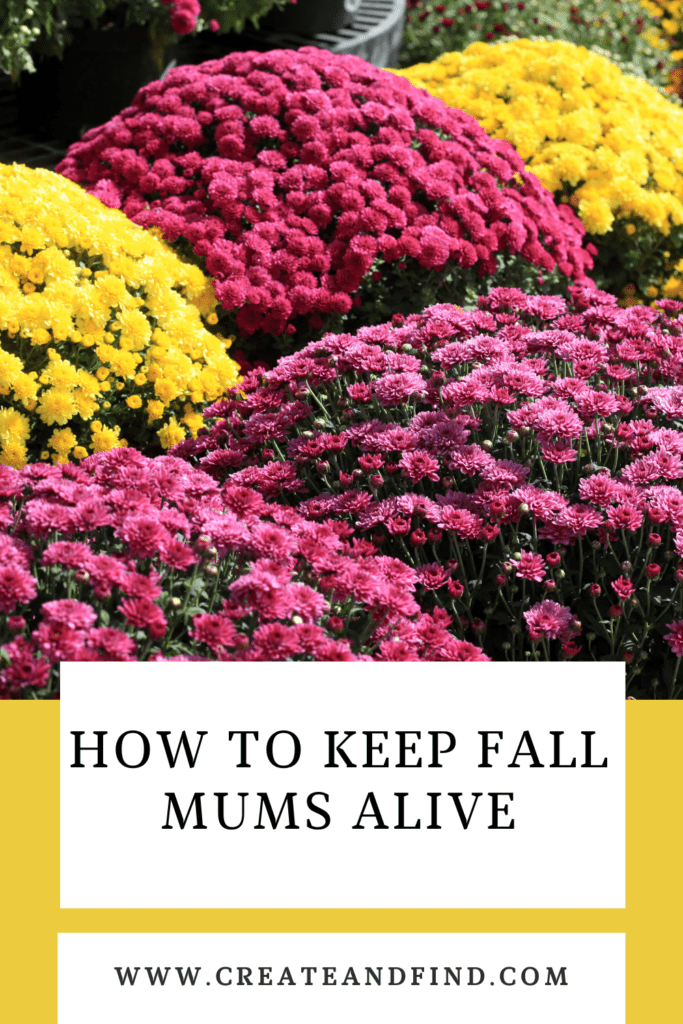Knowing how to keep fall mums alive ensures you enjoy bright colors and hardy plants once the weather cools. As all of your other flowers start to die or go dormant, fall mums bloom in clusters of vibrant shades in most colors in the rainbow.
There are two types of mums. The variety that classifies as fall mums are perennials that will come back year after year with the right care. We’ll look at how to keep fall mums alive and blooming during the active growing season. Then I’ll talk about how to protect fall mums during the winter, so they come back next year.
What are Mums?
Mums – short for Chrysanthemums – are cool-weather-loving plants that erupt in bright, bold colors in fall. You can grow these incredible plants in pots scattered around your porch for decor or planted in your yard for landscaping.
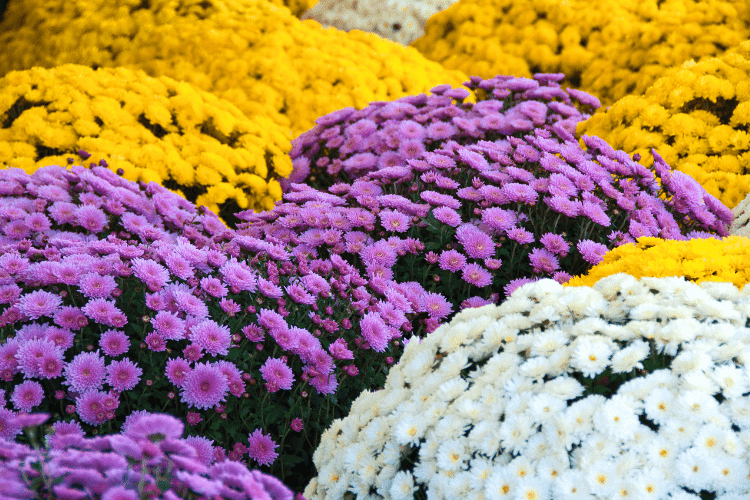
How Long Do Potted Fall Mums Last?
Fall mums are perennials, meaning you can keep them alive for several years, whether you grow them in the ground or pots.
The flowers on potted fall mums can last two to three weeks. And once the flowers die, you can deadhead them – remove them – to encourage new flower growth. Deadheading your fall mums can help them grow longer into the season.
Having your fall mums in pots can come in handy during overwintering to keep your plants alive, so they continue to come back each year.
What Temperatures Do Mums Like?
As the name implies, fall mums prefer cooler autumn conditions when the days are shorter, and the temperatures are lower.
Some Mums cultivars can survive temperatures as low as -20 degrees, as long as they are protected from frost. However, fall mums cannot tolerate hot temperatures.
Do Mums Need Sun or Shade?
Fall mums do best in full direct sun in an area where they get at least six hours of exposure daily. But the more sun they can absorb during the shorter hours of fall, the better.
However, do not plant or place your mums under trees or other shelters where they won’t get the full intensity of the autumn sun when daylight is shorter.
You should consider giving your mums shelter only if you live in a climate where the temperatures stay brutally hot late into the year. The direct, hot sun can cause leaf scorch.
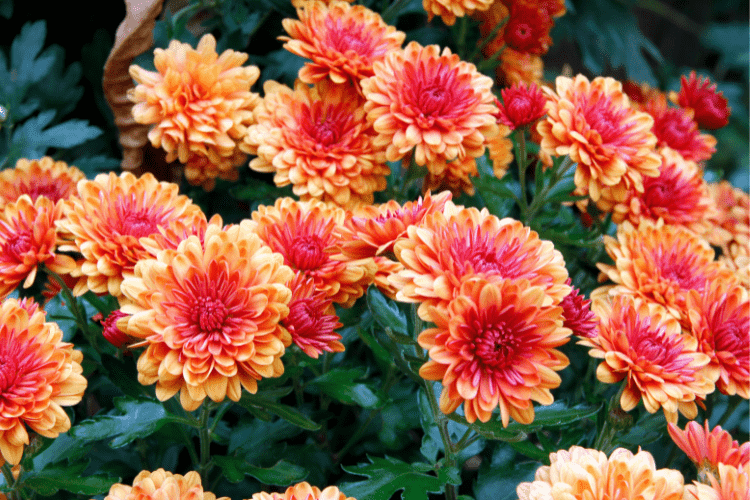
Are Mums Annual or Perennial?
Mums can be annual or perennial, depending on the variety of plants. Annual varieties of Mums are florist’s Mums, while perennial Mums are known as hardy or garden Mums. Only garden mums can grow outside or come back again for several years.
How to Make Mums Bloom Longer
You can get longer growth out of perennial mums than you would florist mums. So if you overwinter hardy mums properly, you can encourage them to rebloom the next season. But florist’s mums are single-season plants that will bloom for the season and then die.
But there are a few cheats that you can use to tease the longest life out of your beautiful blooms until the first frost.
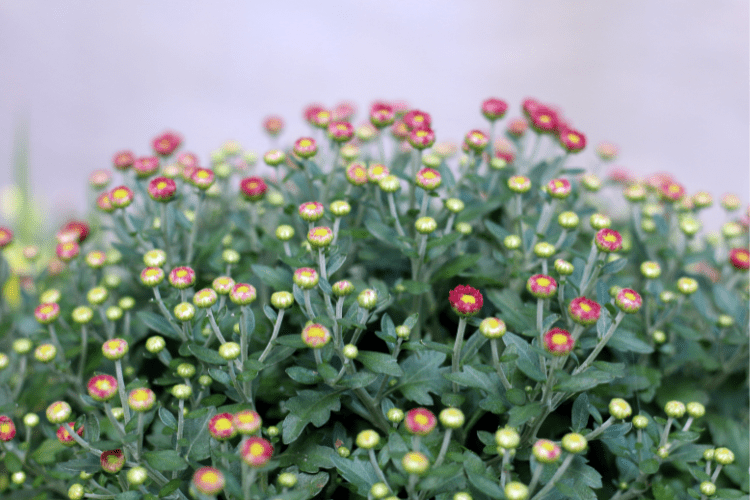
Picking Mums in the Right Stage of Bloom
One trick to keep fall mums alive as long as possible is to purchase the plants at the right flowering time. While it may be tempting to grab a big bushy plant that’s full bloom and heavy with open flowers, resist!
Instead, pick a plant that has a lot of unopened mum buds. Once the flowers open, the clock starts ticking before the flowers wither and die. If you buy a plant with all the flowers open, you’ll only enjoy the sight for a short time – usually two weeks – before the flowers die.
You can enjoy flowers that bloom longer into the fall by choosing plants with buds that haven’t bloomed. The more buds there are, the longer your plant will continue to blossom once you bring it home, giving you beautiful fall color for up to 45 days.
Choosing the Right Variety of Mums
Another way to ensure that you get Mums plants that last as long as possible is to pay attention to the label when shopping for your plants.
There are two varieties of Mums, which can affect how long the plant will live and grow flowers. To get the longest flowering life, you want to pick hardy mums. With the right care – like proper overwintering – hardy Mums can live for several years.
You can identify hardy Mums by the label – they’re usually called garden mums. Or by sight, as they have larger flowers and thicker foliage.
If the label identifies the plant as floral mums, the plant will die once the cold weather hits. They are not winter-hardy. This variety has smaller blooms in clusters on plants that don’t grow as large.
Get the Growing Location Right
You often see Mums plants used for fall landscaping decor in various ways, from growing under the shelter of porches and roof eaves or out in the open with full sun exposure.
The good news is that Fall Mums can tolerate any light and grow quite beautiful in full sun. But the downside is that the hotter and brighter the sun exposure, the faster the Mums flowers will bloom and die off.
Growing flowers in partial shade can slow the blooming process and extend how long flowers stay in bloom. With some shelter from the brutality of the sun’s rays and the heat, fall Mums can bloom for up to two weeks.
Appropriate half-shaded planting areas that are optimal for keeping fall Mums alive and blooming include covered porches or patios by a roof or trees. They also love growing under a canopy of trees.
Avoid Thirsty Plants – Mums Need Water
Nobody likes being thirsty, and that includes your fall Mums. So keeping your plants hydrated is an easy and guaranteed way to keep your plants alive for the longest time.
It’s also important to water your Mums at the right time of day. Wet petals left to the brutal heat of the sun’s rays can experience fading, wrinkling, burning, or scorching. Avoid the hottest parts of the day when the sun is at its full strength.
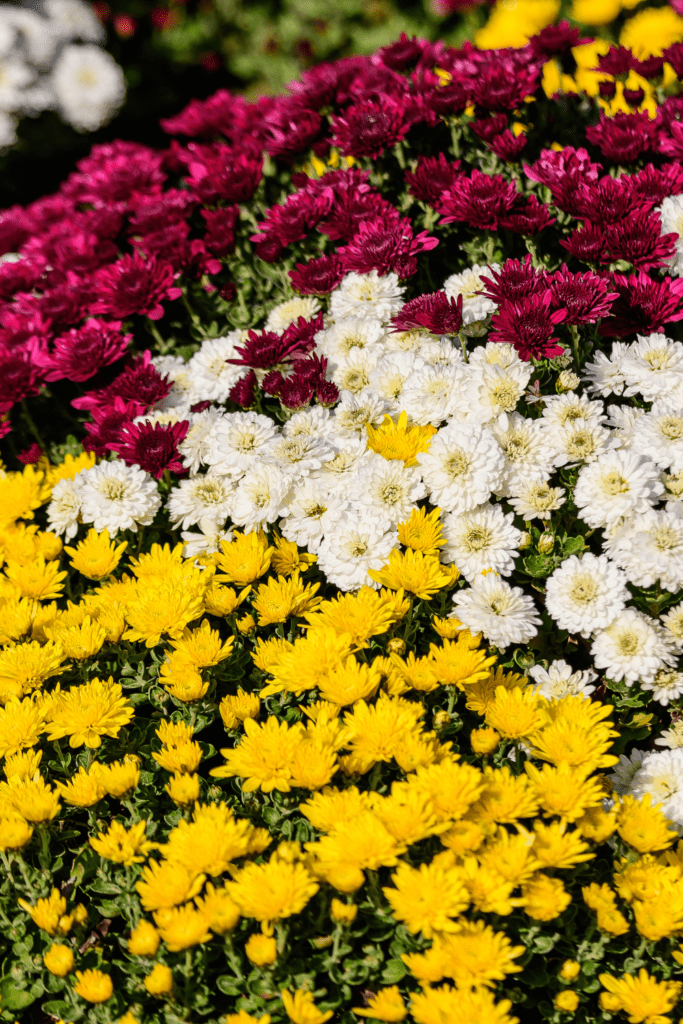
How Often Do I Water Mums?
How you water your Fall Mums is one of the most significant determining factors for how long your plants will stay alive and grow beautiful bright fall flowers. Conversely, inconsistent watering will cause your Mums to have a shorter flowering life.
Fall may have cooler temperatures, which your plants will love. But the air is also less humid and drier, so the dirt will dry out faster. Because of this, it’s best to test your soil’s moisture daily.
The easiest way to check the soil is to insert your finger into the dirt until you reach your second knuckle. If the ground feels damp or your finger comes out with wet soil, you don’t need to provide water.
But your plant requires watering if the dirt feels dry and your finger comes out clean. In these times, soak the plant long enough that the water can get down to the roots.
But remember that Mums are sensitive plants that can get damaged by overhead watering. It can also shorten the flowering cycle and cause the flowers to fade and weaken. And wet blooms are at higher risk of scorching and burning from the sun.
How to Water Fall Mums
The best way to water them is to place the nozzle of your water jug or hose on the soil below the flowers and foliage. Or even better, use a bottom-up watering method, which delivers water to the roots first. Next, place a container or tray under the pot and fill it with water. Then let the plant soak up the water.
There are also self-watering pots that are specifically created for this purpose. And even more beneficial is that these containers can keep your plants watered for up to five days.
Can I Plant Potted Mums in the Ground?
Mums can thrive when transplanted from pots into the ground as long as you do it shortly after bringing your plants home from the nursery.
But if you are trying to plant potted mums that have been in the house, you have to prepare your plants before you can take them out of your plant. First, slowly introduce your plants to the outdoor lighting by bringing the pot outside but putting it in full shade where it can get bright light.
After two or three days, you can move it to an area where it will get a few hours of sun exposure, but shade or coverage protects it from the worst of the sun’s intensity. By day five or six, your plants should be ready to handle six hours of daily sunlight and prepared to go into the ground.
The soil should be properly amended to ensure it will give your Mum plenty of soil aeration and drainage. Add organic matter or compost to prep for Mums if your soil has heavy clay content.
You don’t want to plant your Mums deeper in the ground than they were growing in the pot. Mum’s roots will not do well buried deeply. Spacing is also important – 18″ to 24″ to get adequate airflow to prevent diseases.

Final Words
Growing mums in the fall is a great way to keep vibrant color present in your space after the rest of your garden has gone dormant. When you purchase fall mums, you can follow the tips we laid out for how to keep fall mums alive and blooming for several years. But if you get annual mums, there’s not much you can do to extend their lifespan past a few months.
For more fall planting ideas, check out these stunning flowering fall shrubs or these beautiful fall flowers to plant.
